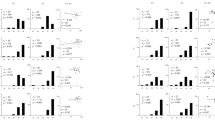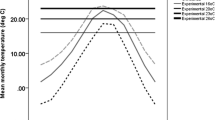Abstract
Populations ofDrosophila pseudoobscura Frolowa initially polymorphic for the third chromosome gene arrangements Standard (ST) and Chiricahua (CH) were allowed to colonise systems of interconnected cages in which each section was subjected to a different regime of temperature and illumination. Estimates of gross productivity and migrational tendencies revealed major differences in favourability amongst the contrasting environments offered in the component units of the three multiple environment cage systems examined. Within each group of interconnected cages migration was permitted continuously throughout the experiments. The development of genetic divergence between the interconnected subpopulations was assessed by comparison of the relative frequencies of the ST and CH gene arrangements, sex-ratio, morphology, genetic variance, developmental stability and behaviour in relation to food preference shown by each subpopulation. In each of the three systems tested significant genetic differentiation between adjoining subpopulations resulted from natural selection within 25–30 generations, in spite of high migration rates and therefore potentially high gene flow.
Similar content being viewed by others
References
Band, H. T. (1963). Genetic structure of populations II. Viabilities and variances of heterozygotes in constant and fluctuating environments.Evolution 17: 307–319.
Band, H. T. &P. T. Ives (1961). Genetic structure of populations I. On the nature of the genetic load in the South Amherst population ofDrosophila melanogaster.Evolution 15: 198–215.
Beardmore, J. A. (1961). Diurnal temperature fluctuation and genetic variance inDrosophila populations.Nature 189: 162–163.
Beardmore, J. A. (1963). Mutual facilitation and the fitness of polymorphic populations.Amer. Nat. 97: 69–74.
Beardmore, J. A. &L. Levine (1963). Fitness and environmental variation I. A study of some polymorphic populations ofDrosophila pseudoobscura.Evolution 17: 121–129.
Carson, H. L. (1959). Genetic conditions which promote or retard the formation of species.Cold Spring Harbor Symp. Quant. Biol. 24: 87–105.
Clutterbuck, A. J. &J. A. Beardmore (1961). Variation in the behaviour of different genotypes ofDrosophila towards odoriferous vegetable oils.Nature 190: 1135–1136.
Dobzhansky, Th. (1961). On the dynamics of chromosomal polymorphism inDrosophila. Symp. Roy. Entomol. Soc. (London)1: 30–42.
Fisher, R. A. (1950). Statistical Methods for Research Workers. 11. ed. Oliver & Boyd, Edinburgh, 354 pp.
Lerner, I. M. (1954). Genetic Homeostasis. Oliver & Boyd, Edinburgh, 134 pp.
Millicent, E. &J. M. Thoday (1960). Gene flow and divergence under disruptive selection.Science 131: 1311–1312.
Millicent, E. &J. M. Thoday (1961). Effects of disruptive selection IV. Gene flow and divergence.Heredity 16: 199–217.
Parsons, P. A. (1961). Fly size, emergence time and sternopleural chaeta number inDrosophila.Heredity 16: 455–473.
Rasmuson, M. (1960). Frequency of morphological deviants as a criterion of developmental stability.Hereditas 46: 511–535.
Thoday, J. M. (1959). The effects of disruptive selection I. Genetic flexibility.Heredity 13: 187–204.
Thoday, J. M. (1963). Concluding address. Symp. Roy. Entomol. Soc. (London)2 (in press).
Thoday, J. M. &J. B. Gibson (1962). Isolation by disruptive selection.Nature 193: 1164–1166.
Thomson, J. A. (1957). A new technique for the study of laboratory populations ofDrosophila.Nature 180: 1495.
Thomson, J. A. (1963). An experimental study of environmental influences on population structure inDrosophila. Proc. XI Int. Congr. Genetics1: 168.
Reeve, E. C. R. &F. W. Robertson (1954). Studies in quantitative inheritance VI. Sternite chaeta number inDrosophila: a metameric quantitative character.Zeits. indukt. Abst. u. Vererbl. 86: 269–288.
Van Valen, L., L. Levine &J. A. Beardmore (1962). Temperature sensitivity of chromosomal polymorphism inDrosophila pseudoobscura.Genetica 33: 113–127.
White, M. J. D. (1962). Genetic adaptation.Aust. Jour. Sci. 25: 179–186.
Wright, S. &Th. Dobzhansky (1946). Genetics of natural populations XII. Experimental reproduction of some of the changes caused by natural selection in certain populations ofDrosophila pseudoobscura.Genetics 31: 125–156.
Author information
Authors and Affiliations
Rights and permissions
About this article
Cite this article
Thomson, J.A. Genetic differentiation within laboratory populations ofDrosophila pseudoobscura . Genetica 35, 270–286 (1964). https://doi.org/10.1007/BF01804895
Received:
Issue Date:
DOI: https://doi.org/10.1007/BF01804895




